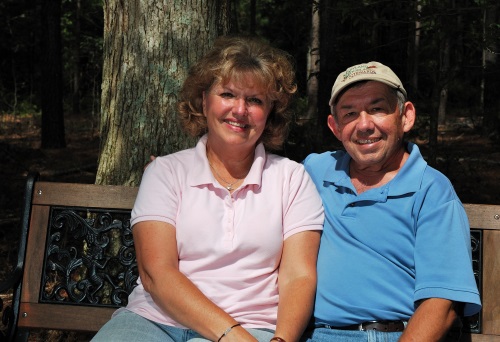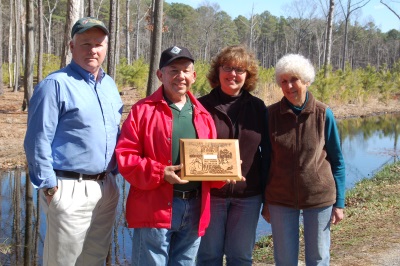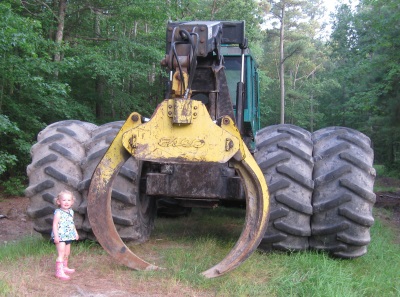Rick and Kathy Abend of Maryland

What makes them outstanding?
Abend Hafen Tree Farm is an exemplary example of what the American Tree Farm System is all about. Rick and Kathy have created a premier demonstration site and have readily used the farm for the past 25 years to show the public how they are sustainably managing their forest resources while providing prime waterfowl and upland wildlife habitat, conserving water resources, and providing an array of recreational opportunities. The farm has been part of the American Tree Farm System since 1989. The Abends promote sustainable forestry management at every opportunity, both on and off their tree farm. Volunteering with other organizations has given the Abends many educational opportunities, both for themselves and opportunities to educate others.
Tree Farmer Story
 Rick Abend grew up in Anne
Arundel Co., MD in a farm house built by his grandfather in 1919. He watched the area around him be developed
as he grew up. He was introduced to
Dorchester Co. when his brothers took him hunting in the 1960ís and he bought
his first 40 acres of hunting property in Crocheron, MD in 1971. That property contained 12 acres of
non-marketable timber salt water influenced loblolly pine and the balance was
marsh. The pond and waterfront provided
excellent duck hunting. It is now part
of Blackwater National Wildlife Refuge.
Rick Abend grew up in Anne
Arundel Co., MD in a farm house built by his grandfather in 1919. He watched the area around him be developed
as he grew up. He was introduced to
Dorchester Co. when his brothers took him hunting in the 1960ís and he bought
his first 40 acres of hunting property in Crocheron, MD in 1971. That property contained 12 acres of
non-marketable timber salt water influenced loblolly pine and the balance was
marsh. The pond and waterfront provided
excellent duck hunting. It is now part
of Blackwater National Wildlife Refuge.
Rick bought the first 49.7
acre wooded parcel of what is now Abend Hafen, German for Evening Haven, Farm
in Madison, MD in 1972. It had a small
cabin on it. His parents and brothers
helped build a larger hunting shack and the cabin became a tool shed. The
hunting shack has been remodeled a few times into the home he and Kathy have
today. Rick used his veteranís benefits
to educate himself by taking correspondence courses through the North American
School of Conservation. The course
included topics on forestry, wildlife management, fisheries, soil conservation,
cost share programs, parks and recreation, and job opportunities. This was followed by an Advanced Wildlife
Management course. It was here that he
first read Aldo Leopoldís A Sand County Almanac. That book is still part of their natural resource
library. In short, the courses pointed
Rick in the right direction. He
constantly sought information from the DNR County Forester, DNR wildlife
biologists, University of Maryland Extension Service, Soil Conservation
Service, and Dorchester Co. Soil Conservation District. His first cost share assistance was used in
1974 to build a 4000 foot roadway through the woods and a pond. This provided fishing, fire protection, and
access for a future timber harvest. The
first forest management plan was written in 1975. 
Rick wanted to do more management for waterfowl. Three adjacent parcels were purchased in the mid 1980ís. These contained mostly agricultural fields, but also included six more acres of loblolly pine. Abend Hafen Farm now totals 106 acres. To develop waterfowl habitat, a 10 year waterfowl habitat license agreement was signed with the Maryland DNR. The project was funded with a 22 acre timber harvest. Four moist soil impoundments were built. The pond was enlarged, a well was drilled and a wood duck nesting box program was started. The 20 acres reforested in 1989 are now a beautiful stand of 25 year old pole timber. This stand has already produced several thousand dollars in income from the sale of over 2000 fish trap poles and a pulpwood harvest. After a 30 year career with the National Security Agency at Ft. Meade, MD, Rick was able to retire and move to the farm in 1997.
Kathy was born and raised in Illinois. A farm girl at heart, having driven combines and other farm equipment, she actually came to Maryland in 2003 as a traveling Registered Nurse. In addition to her nursing degree, she has a Bachelor of Science degree in Health Care Management and recently received a Master of Business Administration degree from Mount St. Maryís University in Frederick, MD in 2014.
Kathy and Rick married in April 2006. As an integral part of the farm management, Kathy attended the 2008 Maryland Woodland Stewards Workshop at Camp Pecometh in Centreville, MD to learn more about Maryland forestry practices and wildlife management. Kathyís mother, Jean Small, attended the 2012 MWS class in Sharpsburg, MD. When the farm CRP contract was up for renewal, Kathy and Rick established the vegetative filter strips in the CRP/CREP acreage. They also annually plant the food plots in and around the impoundments, sometimes with the help of their grandchildren. The couple keep their property lines well marked using light blue no trespassing paint marks on the trees. Kathy also enjoys gathering, cutting and splitting firewood and she excels at hosting farm tours! The Abends are both avid photographers. Most of the wildlife species, and many of the management practices, are documented in pictures.
Awards received have included: 1990 Dorchester County Outstanding Tree Farmer Award, 1992 Dorchester County Soil Conservation District Take Pride in America Conservation Farm Award, 1998 Eastern Shore Land Conservancy Heart of the Shore Award, and 2014 Maryland Outstanding Tree Farmers of the Year Award.
Wood
The Abends manage 46 acres of timber. The primary crop tree is loblolly pine. Through timber harvests in 1988 and 2010, the Abends have sold over 317 thousand board feet of saw timber. Both federal and state cost share programs have been used for reforestation and timber stand improvement projects. Rick also sprayed for gypsy moths for several years in the mid-1990ís. Commercial pulpwood harvests in 1988 and 2007 totaling 1184 tons have improved the timber stands and enhanced the wildlife habitat. The Abends marketed over 2000 pound net poles to commercial fishermen over several years. This niche market was much more lucrative than the pulpwood sales. After their 2010 harvest of 14 acres they allowed several people to cut firewood from the remaining tops all winter long, just leaving the owners a little firewood for each pick-up truck load cut. This greatly improved the 2011 reforestation of this tract. A seedling survival count that winter yielded 520 pine trees per acre. Hurricanes Irene and Sandy were devastating. They toppled 30 mature oaks and beech that had been left for wildlife during the 2010 harvest. In 2011-12, the Abends carefully salvaged these trees from the newly reforested acreage. They provided over 30 cords of firewood. During a 2012 pine release backpack spraying of hardwood sprouts, the oak sprouts were saved and Rick selected a main stem from each stump to push the oak recovery. In 2012, Rick also cruised their 6 acres of mature pines and found over 108,000 board feet available for future harvest. In a conservation easement donated to the Maryland Environmental Trust and Eastern Shore Land Conservancy in 1992, Rick ensured that the easement protects the right to manage the timber resources in perpetuity in accordance with the Maryland Forest Serviceís Best Management Practices.
Water
Water resources on the farm include a ĺ acre pond (stocked with largemouth bass and bluegills) and four moist soil impoundments comprising 5 Ĺ acres which are drained and planted each summer. A two acre impoundment is set up as a mini green tree reservoir containing an acre of bald cypress trees. The dikes around the impoundments are maintained in grasses and clover. The field impoundment contains a sump pit behind the dike to trap sediment when drained in the spring. The farm contains 50 acres of fields along a half mile of MD. Rt. 16. Farm drainage empties into the Little Choptank River. A three acre windbreak along the highway locks the soil in place. In addition, 14 acres are maintained in vegetation filter strips around the cropped portion of each field as CRP/CREP acres. Only 32 acres are tilled. The CRP/CREP acreage is mowed annually. Other cost share programs used for water conservation have included ACP and SIP.
Wildlife
All management activities on the farm are done with wildlife in mind. Doing small modified clearcut harvests, leaving mature hardwoods scattered throughout the harvest areas, have benefitted wildlife like the endangered Delmarva fox squirrel, deer, and turkeys. Snags have been left for woodpeckers. Bald eagles are often seen hunting in these areas. The age diversity of the timber enhances the area for a wider variety of wildlife. A three acre windbreak planted along the highway provides wildlife habitat and privacy for resting Canadian geese. Seven acres within the 14 CRP/CREP acres have been planted in warm season grasses for nesting habitat. Four moist soil impoundments totaling 5 Ĺ acres are planted in a sorghum/Japanese millet mixture for waterfowl and deer. Additional food plots are planted wherever possible. In the past, Marylandís WHIP program helped defray food plot costs. Roadways are planted in clover for deer and turkey bugging areas. Artificial nesting structures have been placed throughout the farm for bluebirds, wood ducks and ospreys. The Abends encourage backyard wildlife with various garden plants, bird feeders, bird houses, and water structures. They participate in Marylandís Acres for Wildlife program.
Recreation
Recreational activities include hunting, fishing, wildlife photography, bird watching, and hiking. While some areas of the timber can get wet during the winter, a well maintained road system provides year round access. Observation lanes are maintained around several deer stands for hunting and photography. Hunters provide a great source of labor for various farm projects. Three age classes of timber and scattered hardwoods left in harvest areas provide excellent birding areas. A trail system is being developed for birding and hiking. Three benches have been placed along the trails and 10 culverts placed in ditches throughout the farm in 2012 improve access. The main farm road is mowed all summer. The woods trails are mowed annually. The pond and moist soil impoundments provide excellent waterfowl and wading bird photography opportunities. Guests are invited to use the photography blinds. The pond is stocked with largemouth bass and bluegills for the fishing enthusiast. A swing and picnic table under a large white oak near the pond provides a relaxing place to spend an afternoon. Our state tree, a national champion white oak known as the Wye Oak was lost in a storm in 2002. As a special site, Rick planted a descendent of this tree near the pond in 1994. It is now over 20 feet tall. Aesthetics are important to the Abends. By maintaining buffers during timber harvests, the public has pretty much been unaware of harvest activity except for the Logging Trucks Entering Highway signs.


